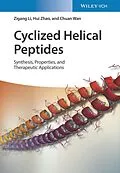An important and timely guide to the progress being made on constrained helical peptides
Constraint helical peptides have emerged as a solution to target previously undruggable protein-protein interactions, which feature large and complex surfaces. Cyclized Helical Peptides: Synthesis, Properties and Therapeutic Applications offers a review of the most current methodologies of constructing constrained helices. The authors noted experts on the topic include the information on the fundamental features of cyclized helical peptides and discuss their limitations. The book summarizes and explores the effects of chemical methods constructing helical peptides on helicity, binding affinity, cell penetration, and nonspecific toxicity.
The book examines the therapeutic applications of the constraint helices and includes comparison with existing small molecule modulators or antibodies. Designed as a useful resource for both those outside and inside the field. Those new to the field will find a comprehensive introduction to cyclized helical peptide and those inside the field will find a deeper understanding of the topic.
This important book:
- Offers a practical introduction to constrained helical peptides
- Includes all aspects of constrained helical peptides
- Includes information on the most recent methods that have emerged
- Presents a guide to help solve practical problems in the field
Written for academics, pharmaceutical professional, Cyclized Helical Peptides is a comprehensive guide to the developments of constrained helical peptides.
Autorentext
Zigang Li is a professor in School of Chemical Biology and Biotechnology of Peking University, and the executive deputy director and senior researcher in the Shenzhen Bay Laboratory Pingshan Translational Medicine Center.
Hui Zhao is an investment manager of Shenzhen Angel FOF, with experience in industry research and investment, in the field of innovative drugs and medical devices.
Chuan Wan is a post-doctoral student under the supervision of Prof. Zigang Li.
Inhalt
1 Introduction 1
1.1 ProteinProtein Interactions and Their Small-Molecule Modulators 1
1.1.1 Characteristics of ProteinProtein Interactions 1
1.1.2 Intervention of ProteinProtein Interactions Using Small Molecules 3
1.1.2.1 Leukocyte Function-Associated Antigen-1 5
1.1.2.2 Inhibitor of Apoptosis Proteins 6
1.1.2.3 Bromodomains 6
1.1.2.4 Human Immunodeficiency Virus Integrase 6
1.1.2.5 B-Cell Lymphoma-2 Family/B-Cell Lymphoma-2 Homology 3 Proteins Interaction 7
1.1.2.6 Mouse Double Minute 2p53 Interaction 7
1.2 Features of Peptide as Molecular Tools 8
1.2.1 Advantages of Peptides as Molecular Tools 8
1.2.2 Disadvantages of Peptides as Molecular Tools 11
1.3 Helical Structures and Their Characterization 12
1.3.1 Different Types of Helices 12
1.3.1.1 -Helix 12
1.3.1.2 310-Helix 12
1.3.1.3 -Helix 13
1.3.2 Characterization of Helical Peptides 15
1.3.2.1 Circular Dichroism 15
1.3.2.2 X-ray Crystallography 16
1.3.2.3 Nuclear Magnetic Resonance (NMR) 17
1.4 Stabilization of Peptides 18
1.4.1 Peptide Stabilization via Cyclization 18
1.4.1.1 Monocyclization 18
1.4.1.2 Multicyclization 19
1.4.2 Peptide Stabilization via Backbone Reconstruction 21
1.4.2.1 Methylation 21
1.4.2.2 Foldamers 23
References 27
2 Construction of Constrained Helices 35
2.1 Side-Chain Cross-linking 35
2.1.1 Disulfide Bond 35
2.1.2 Amide and Ester 37
2.1.3 All-Hydrocarbon Stapled Peptide 42
2.1.4 Thioether 48
2.1.5 Azole 56
2.2 End Nucleation 57
2.2.1 Macrocycle-Based N-cap Templates 58
2.2.2 Hydrogen Bond Surrogate Approaches 60
2.2.3 N-Terminal Side Chain Constrains as Helix-Nucleating Templates 61
References 62
3 Properties of Stabilized Peptides 69
3.1 Helicity 69
3.1.1 Ring Size 69
3.1.2 Rigidity 74
3.1.3 Comparison 79
3.2 Binding Affinity 80
3.2.1 Helicity 80
3.2.2 Cyclization Position 81
3.2.3 Substitution 84
3.3 Cell Permeability 84
3.3.1 Amphiphilicity: Hydrophobicity and Isoelectric Point 84
3.3.2 Helicity 87
3.3.3 Summary 89
3.4 Nonspecific Toxicity 89
3.5 Stability 91
3.5.1 Proteolytic Stability 91
3.5.2 Pharmacokinetic Properties 95
3.6 Additional Features 98
References 103
4 Applications of Constrained Helices 107
4.1 Cancer 107
4.1.1 MDM2/X 107
4.1.2 B-Cell Lymphoma 2(MCL-1/BCL-2/BCL-XL)-BID/Noxa/BAX/BIM/PUMA 110
4.1.3 NOTCH 114
4.1.4 Insulin Receptor Substrate 1 118
4.1.5 Ras 120
4.1.6 Rab 124
4.1.7 -Catenin BCL-9/AXIN 126
4.1.8 Epidermal Growth Factor Receptor 130
4.1.9 Estrogen Receptor 135
4.1.10 Hypoxia-Inducible Factor 138
4.1.11 Embryonic Ectoderm Development Enhancer of Zeste Homolog 2 140
4.2 Infectious Disease 143
4.2.1 HIV 143
4.2.2 Respiratory Syncytial Virus F (RSV) 148
4.3 Metabolic Disease 150
4.3.1 Glucokinase-Phospho-BAD 150
References 152
5 Stabilized Peptide Covalent Inhibitors 159
5.1 Methodologies of Peptide Covalent Inhibitor 159
5.1.1 Covalent Warhead 160
5.1.2 Stapling Method 162
5.2 Applications 162
5.2.1 BCL-2 Family Proteins As Target 163
5.2.2 MDM2 and MDM4 As Target 164
5.2.3 Sulfonium Tethered Peptide 168
5.2.4 Others 176
References 177
6 Stabilized Peptide PROTAC 181&l...
